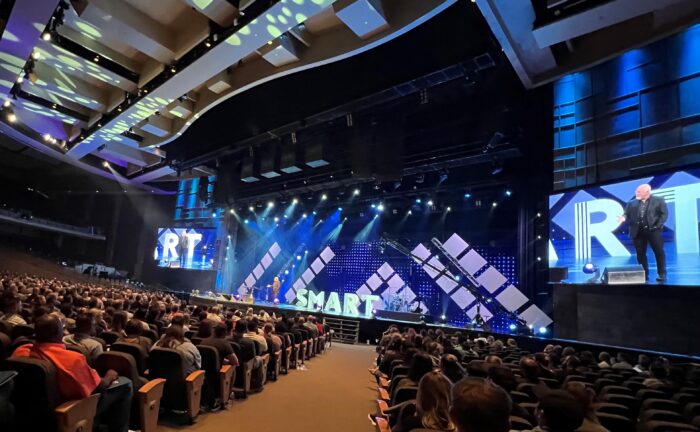
Presentation Learnings from a Dave Ramsey Event
I am a huge fan of great presentations. Unfortunately, in the business world many (most?) presentations are weak; they are plodding, cluttered and dull. People like to blame PowerPoint, but the issue isn’t the software platform. I think the issue is that people haven’t studied and just don’t know how to present well.
My book on presenting, How to Wash a Chicken: Mastering the Business Presentation, is designed to help people improve.
Last week I heard that Dave Ramsey was hosting a conference in Chicago. Ramsey is a financial thought-leader perhaps best known for his focus on living a debt free life. According to Dave and his team, the key to financial peace is getting rid of debts. I think he is right.
Dave Ramsey runs a lot of conferences, so I was intrigued. How does Ramsey run a live event? What can we learn from Ramsey and his team about presentations? So, I signed up for a Saturday with Dave and his personalities such as John Delony and Jade Warshaw. Here is what I learned.
Set the Mood
The conference was scheduled to start at 9 AM. I wandered in at about 8:45. There was music playing as people gathered, and then at 8:55, a cover band took the stage. They were amazing, with terrific energy. All of this built the momentum heading into the actual start when the MC bounded out, exactly at 9.
The Ramsey team knows that the time before a presentation starts is just as important as the presentation itself.
Start with a Story
Speakers often begin with some platitudes, perhaps “I’m so happy to be here” or “Thank you for that amazing introduction.” These comments add no value.
At the Ramsey conference, each presenter started with a story. This approach quickly got people engaged; people like stories. Jade Warshaw talked about her debt. John Delony talked about not being able to sleep.
Indeed, all of the presentations featured stories. The ratio of stories to facts was about 7:1. The insight is simple: stories are interesting and fun. Facts and figures are important, but best used sparingly.
Bring the Energy and Focus
At the Ramsey event, each speaker was dialed in. It was astonishing to see the energy and intensity. They used eye contact, hand gestures, and movement to project focus. You had the sense each one took the opportunity to present seriously and was working very hard to be of service to the audience.
Were they nervous? I suspect they were. But the nervousness came across as intensity and it worked.
Use Analogies and Visuals
Two easy ways to bring a situation to life are analogies and visuals.
Analogies are a useful way to help people understand an unfamiliar situation. Dave compared the process of getting control of your financials to his experience running a marathon. You just keep moving forward, step by step. His marathon story was fun and relatable. The comparison is helpful.
John Delony compared anxiety to a fire alarm going off. He then noted, the problem usually isn’t the fire alarm. The problem is the fire. The analogy was a simple way to understand stress. Sometimes the problem isn’t the anxiety, it is the things causing the anxiety.
The highlight of Jade Warshaw’s talk was a list of all her debts. At one point she was more than $400,000 behind. That is quite a figure. It took on more meaning, however, when she showed the actual hand-written list. She owed this much to Capital One, this much to Discover. It was quite a list.
Don’t Carry Notes
There were no notes. The speakers didn’t carry papers, read from a computer, or hide behind a podium. In truth, there wasn’t a podium to hide behind. They were just on a stage talking in a natural fashion.
There were confidence monitors, but they were very low to the ground and the speakers rarely used them. I wonder what was on the monitor.
Give People Breaks
The program timing was interesting. Session 1 went for just over an hour, followed by a 25-minute break. Then session 2 went on for about an hour. Then lunch was 90 minutes.
Ninety minutes for lunch? That struck me as an absurd amount of time. I was ready to get going in twenty minutes.
But I think I was the only one who found the break excessive. Most people happily lined up at the food trucks, enjoyed their meal, and eventually ambled back.
I think the Ramsey team has learned that people don’t mind breaks. Many came with friends and used the open time to catch-up. Or they compared notes with other Ramsey followers. Reducing the time for lunch might have made people feel rushed (rushed causes anxiety!).
A long break or a long time for lunch isn’t a bad thing.
Overall
It was an impressive event. There were a few things I would have done differently. I would have liked the speakers to have started with an objective and then an agenda. More audience interaction would have been great. I’m not sure why they didn’t ever come down off the stage.
That is the fun part of presenting. If you watch others, you can always find things that work and things that might have been better. Becoming a student of the craft is how we all improve.
Agreed on the generous breaks – was there to learn. All the personalities were polished, well-spoken, and didn’t use filler words. And Dave had a great, motivating wrap-up with his segue into the high-energy One Republic tune. Perhaps most telling for me was that even the goofy Family Feud segment made it obvious that these folks LOVE being on the same team and doing work and life together. What a great culture!
Kevin–I agree…the group had great energy. Another good learning: presentations are always better when you seem happy to be there!